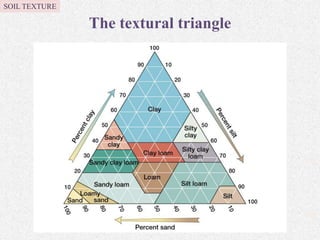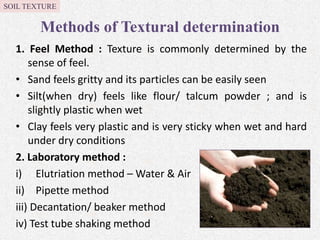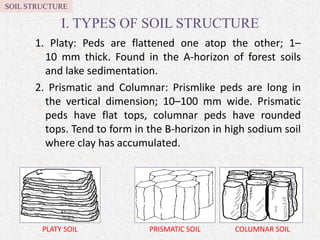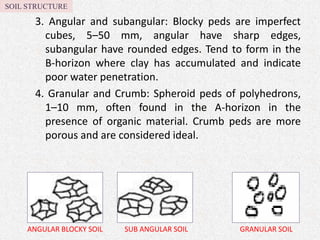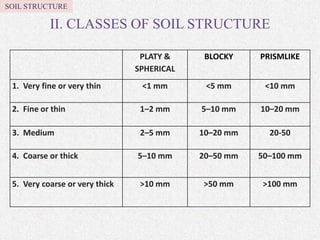Soil texture and soil structure
- 1. SOIL TEXTURE AND SOIL STRUCTURE
- 2. SOIL TEXTURE Soil texture refers to the relative percentage of sand, silt and clay in a soil. The proportion of each size in a given soil (the texture) cannot be easily altered and it is considered as a basic property of a soil. The soil separates are defined in terms of diameter in millimeters of the particles. Soil particles less than 2 mm is called fine earth and are excluded from soil textural determinations. SOIL TEXTURE
- 3. Soil Textural Classes Sand: It includes all soils in which the sand separates make up at least 70% of the material by weight. Silt: It includes soils with at least 80% silt and 12% or less clay. Particle size intermediate between sand and clay. Clay: It includes soils with at least 35-40% clay separate. SOIL TEXTURE
- 4. The textural triangle SOIL TEXTURE
- 5. Methods of Textural determination 1. Feel Method : Texture is commonly determined by the sense of feel. ? Sand feels gritty and its particles can be easily seen ? Silt(when dry) feels like flour/ talcum powder ; and is slightly plastic when wet ? Clay feels very plastic and is very sticky when wet and hard under dry conditions 2. Laboratory method : i) Elutriation method ©C Water & Air ii) Pipette method iii) Decantation/ beaker method iv) Test tube shaking method SOIL TEXTURE
- 6. SOIL TEXTURE Influence of Soil Texture Separates on Some Properties of Soils Property/behavior Sand Silt Clay Water-holding capacity Low Medium to high High Aeration Good Medium Poor Drainage rate High Slow to medium Very slow Soil organic matter level Low Medium to high High to medium Decomposition of organic matter Rapid Medium Slow Warm-up in spring Rapid Moderate Slow Compactability Low Medium High Shrink/Swell Potential Very Low Low Moderate to very high Ability to store plant nutrients Poor Medium to High High
- 7. The arrangement of primary particles (sand, silt, clay) and their aggregates into a certain definite pattern is called soil structure. Influence of soil structure on soil physical properties: ? Aeration/ Porosity ? Temperature ? Density ? Consistency ? Colour ? Etc. SOIL STRUCTURE SOIL STRUCTURE
- 8. I. TYPES OF SOIL STRUCTURE 1. Platy: Peds are flattened one atop the other; 1©C 10 mm thick. Found in the A-horizon of forest soils and lake sedimentation. 2. Prismatic and Columnar: Prismlike peds are long in the vertical dimension; 10©C100 mm wide. Prismatic peds have flat tops, columnar peds have rounded tops. Tend to form in the B-horizon in high sodium soil where clay has accumulated. SOIL STRUCTURE PLATY SOIL COLUMNAR SOILPRISMATIC SOIL
- 9. 3. Angular and subangular: Blocky peds are imperfect cubes, 5©C50 mm, angular have sharp edges, subangular have rounded edges. Tend to form in the B-horizon where clay has accumulated and indicate poor water penetration. 4. Granular and Crumb: Spheroid peds of polyhedrons, 1©C10 mm, often found in the A-horizon in the presence of organic material. Crumb peds are more porous and are considered ideal. SOIL STRUCTURE ANGULAR BLOCKY SOIL SUB ANGULAR SOIL GRANULAR SOIL
- 10. II. CLASSES OF SOIL STRUCTURE SOIL STRUCTURE PLATY & SPHERICAL BLOCKY PRISMLIKE 1. Very fine or very thin <1 mm <5 mm <10 mm 2. Fine or thin 1©C2 mm 5©C10 mm 10©C20 mm 3. Medium 2©C5 mm 10©C20 mm 20-50 4. Coarse or thick 5©C10 mm 20©C50 mm 50©C100 mm 5. Very coarse or very thick >10 mm >50 mm >100 mm
- 11. III. GRADES OF SOIL STRUCTURE 1. Structureless: No aggregation or orderly arrangement. Soil is entirely cemented together in one great mass. 2. Weak: Poorly formed; Non-durable. Weak cementation allows peds to fall apart. 3. Moderate: Well formed; moderately durable. Indistinct in undisturbed soil but may break into aggregates. This is considered ideal. 4. Strong: Well formed; durable. Peds are distinct before removed from the profile and do not break apart easily. SOIL STRUCTURE
- 12. FACTORS AFFECTING SOIL STRUCTURE 1. Climate: Climate influences the degree of aggregation as well as on the type of soil structure. In arid regions there is very little aggregation. In semi arid regions, the degree of aggregation is greater. 2. Organic matter: Organic matter improves the structure of sandy soil & clay soil. In case of sandy soil, the sticky and slimy material produced by decomposing om cement the sand particles together to form aggregates. In case of clayey soil, it modifies the properties of clay by reducing its cohesiveness. This helps make clay more crumby. 3. Adsorbed cations: Aggregate formation is influenced by nature of cation adsorbed. Na? --- Deflocculation --- Poor structure Ca?? --- Flocculating --- Good structure SOIL STRUCTURE
- 13. 4. Tillage: Intensive cultivation increased infiltration capacity and penetrability, but spolied soil structure. For obtaining good soil structure, tillage operation should be made at optimum moisture conditions. 5. Type of vegetation: Grasslands and forest soils have high stability of aggregates. 6. Animals: Among the soil fauna small animals like earthworms, moles and insects etc., that burrow in the soil are the chief agents that take part in the aggregation of finer particles. 7. Microbes: Algae, fungi, actinomycetes and fungi keep the soil particles together. 8. Fertilizers: Fertilizer like Sodium Nitrate destroys granulation by reducing the stability of aggregates. Few fertilizers for example, CAN help in development of good structures. 9. Wetting and drying: When a dry soil is wetted, the soil colloids swell on absorbing water. On drying, shrinkage produces strains in the soil mass gives rise to cracks, which break it up into clods and granules of various sizes. SOIL STRUCTURE
- 14. Role of soil structure in relation to plant growth ?Soil structure influences the amount and nature of porosity. ?Structure controls the amount of water and air present in the soil. ?It affects tillage practices. ?Structure controls runoff and erosion. ?Platy structure normally hinders free drainage whereas sphere like structure (granular and crumby) helps in drainage. ?Crumby and granular structure provides optimum infiltration, water holding capacity, aeration and drainage. ?It also provides good habitat for microorganisms and supply of nutrients.
- 15. THANK YOU



